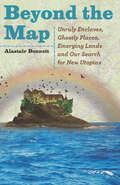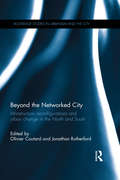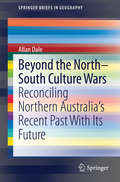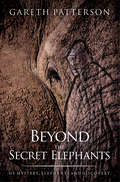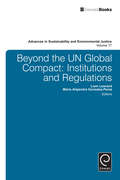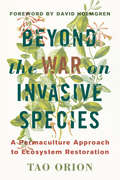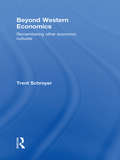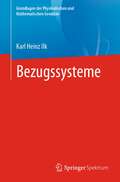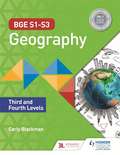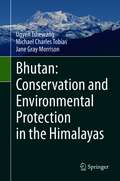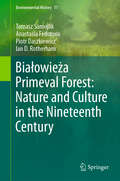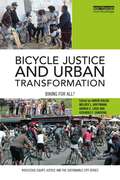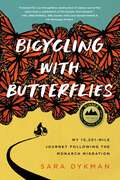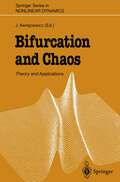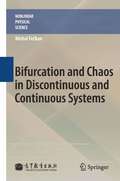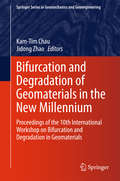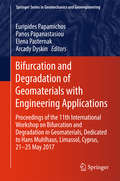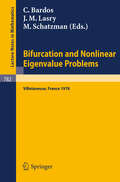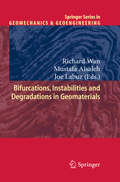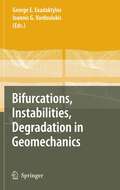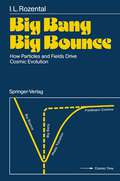- Table View
- List View
Beyond the Map: Unruly Enclaves, Ghostly Places, Emerging Lands and Our Search for New Utopias
by Alastair BonnettNew islands are under construction or emerging because of climate change. Eccentric enclaves and fantastic utopian experiments are multiplying. Once-secret fantasy gardens are cracking open their doors to outsiders. Our world is becoming stranger by the day—and Alastair Bonnett observes and captures every fascinating change. In Beyond the Map, Bonnett presents stories of the world’s most extraordinary spaces—many unmarked on any official map—all of which challenge our assumptions about what we know—or think we know—about our world. As cultural, religious and political boundaries ebb and flow with each passing day, traditional maps unravel and fragment. With the same adventurous spirit he effused in the acclaimed Unruly Places, Bonnett takes us to thirty-nine incredible spots around the globe to explore these changing boundaries and stimulate our geographical imagination. Some are tied to disruptive contemporary political turbulence, such as the rise of ISIL, Russia’s incursions into Ukraine and the Brexit vote in the United Kingdom. Others explore the secret places not shown on Google Earth or reflect fast-changing landscapes. Beyond the Map journeys out into a world of mysterious, daunting and magical spaces. It is a world of hidden cultures and ghostly memories, of uncountable new islands and curious stabs at paradise. From the phantom tunnels of the Tokyo subway to a stunning movie-set re-creation of 1950s-era Moscow; from the caliphate of the Islamic State to virtual cybertopias—this book serves as an imaginative guide to the farthest fringes of geography.
Beyond the Map: Unruly Enclaves, Ghostly Places, Emerging Lands and Our Search for New Utopias
by Alastair BonnettNew islands are under construction or emerging because of climate change. Eccentric enclaves and fantastic utopian experiments are multiplying. Once-secret fantasy gardens are cracking open their doors to outsiders. Our world is becoming stranger by the day—and Alastair Bonnett observes and captures every fascinating change. In Beyond the Map, Bonnett presents stories of the world’s most extraordinary spaces—many unmarked on any official map—all of which challenge our assumptions about what we know—or think we know—about our world. As cultural, religious and political boundaries ebb and flow with each passing day, traditional maps unravel and fragment. With the same adventurous spirit he effused in the acclaimed Unruly Places, Bonnett takes us to thirty-nine incredible spots around the globe to explore these changing boundaries and stimulate our geographical imagination. Some are tied to disruptive contemporary political turbulence, such as the rise of ISIL, Russia’s incursions into Ukraine and the Brexit vote in the United Kingdom. Others explore the secret places not shown on Google Earth or reflect fast-changing landscapes. Beyond the Map journeys out into a world of mysterious, daunting and magical spaces. It is a world of hidden cultures and ghostly memories, of uncountable new islands and curious stabs at paradise. From the phantom tunnels of the Tokyo subway to a stunning movie-set re-creation of 1950s-era Moscow; from the caliphate of the Islamic State to virtual cybertopias—this book serves as an imaginative guide to the farthest fringes of geography.
Beyond the Networked City: Infrastructure reconfigurations and urban change in the North and South (Routledge Studies in Urbanism and the City)
by Olivier Coutard Jonathan RutherfordCities around the world are undergoing profound changes. In this global era, we live in a world of rising knowledge economies, digital technologies, and awareness of environmental issues. The so-called "modern infrastructural ideal" of spatially and socially ubiquitous centrally-governed infrastructures providing exclusive, homogeneous services over extensive areas, has been the standard of reference for the provision of basic essential services, such as water and energy supply. This book argues that, after decades of undisputed domination, this ideal is being increasingly questioned and that the network ideology that supports it may be waning. In order to begin exploring the highly diverse, fluid and unstable landscapes emerging beyond the networked city, this book identifies dynamics through which a ‘break’ with previous configurations has been operated, and new brittle zones of socio-technical controversy through which urban infrastructure (and its wider meaning) are being negotiated and fought over. It uncovers, across a diverse set of urban contexts, new ways in which processes of urbanization and infrastructure production are being combined with crucial sociopolitical implications: through shifting political economies of infrastructure which rework resource distribution and value creation; through new infrastructural spaces and territorialities which rebundle socio-technical systems for particular interests and claims; and through changing offsets between individual and collective appropriation, experience and mobilization of infrastructure. With contributions from leading authorities in the field and drawing on theoretical advances and original empirical material, this book is a major contribution to an ongoing infrastructural turn in urban studies, and will be of interest to all those concerned by the diverse forms and contested outcomes of contemporary urban change across North and South.
Beyond the Networked City: Infrastructure reconfigurations and urban change in the North and South (Routledge Studies in Urbanism and the City)
by Olivier Coutard Jonathan RutherfordCities around the world are undergoing profound changes. In this global era, we live in a world of rising knowledge economies, digital technologies, and awareness of environmental issues. The so-called "modern infrastructural ideal" of spatially and socially ubiquitous centrally-governed infrastructures providing exclusive, homogeneous services over extensive areas, has been the standard of reference for the provision of basic essential services, such as water and energy supply. This book argues that, after decades of undisputed domination, this ideal is being increasingly questioned and that the network ideology that supports it may be waning. In order to begin exploring the highly diverse, fluid and unstable landscapes emerging beyond the networked city, this book identifies dynamics through which a ‘break’ with previous configurations has been operated, and new brittle zones of socio-technical controversy through which urban infrastructure (and its wider meaning) are being negotiated and fought over. It uncovers, across a diverse set of urban contexts, new ways in which processes of urbanization and infrastructure production are being combined with crucial sociopolitical implications: through shifting political economies of infrastructure which rework resource distribution and value creation; through new infrastructural spaces and territorialities which rebundle socio-technical systems for particular interests and claims; and through changing offsets between individual and collective appropriation, experience and mobilization of infrastructure. With contributions from leading authorities in the field and drawing on theoretical advances and original empirical material, this book is a major contribution to an ongoing infrastructural turn in urban studies, and will be of interest to all those concerned by the diverse forms and contested outcomes of contemporary urban change across North and South.
Beyond the North-South Culture Wars: Reconciling Northern Australia's Recent Past With Its Future (SpringerBriefs in Geography)
by Allan DaleIncreasingly, Australia’s agriculturalists are looking to the nation’s north to escape the decline in southern Australia’s water and soil resources. Booming mineral and gas development is also helping to drive the nation’s economic success. At the same time, the south’s conservation sector would like to see much of the north preserved as iconic wilderness. Both conservation and resource development interests alike are often at odds with the interests of the north’s traditional owners, many of whom remain trapped in welfare dependency and poverty. Indeed, to the ire of north Australians, the past five decades of north Australian history have indeed been characterized by these national-scale conflicts being played out in regional and local communities.This book explores these conflicts as well as the many emerging opportunities facing the development of the north, suggesting that a strong cultural divide between northern and southern Australia exists; one that needs to be reconciled if the nation as a whole is to benefit from northern development. The author first explores where these historical conflicts could take us without a clear forward agenda. A story-based personal narrative from his long and diverse experience in the north gives life to these themes. Finally, the book then draws on these stories to help shape a cohesive agenda for the north’s future.
Beyond the Secret Elephants: On mystery, elephants and discovery
by Gareth PattersonBeyond the Secret Elephants is Gareth Patterson’s long-awaited sequel to The Secret Elephants, published in 2009.Beyond the Secret Elephants is the continuing story of Gareth Patterson’s almost two decades of research into the secretive Knysna elephants. Significantly, however, it also reveals his startling discovery of a much more mysterious being than the elephants – a relict hominoid known to the indigenous forest people as the Otang.Gareth had long heard about the existence of the otang from the local people but he mentioned it only briefly in The Secret Elephants, focusing instead on his rediscovery of the Knysna elephants and their survival against the odds. He was reluctant to blur the story of the elephants with his findings about the otang.That is, until now.The possible existence of relict hominoids is today gaining momentum worldwide with ongoing research into Bigfoot in North America, the Yeti in the Himalayas and the Orang Pendek in Sumatra. Eminent conservationists and scientists – among them Dr Jane Goodall, Dr George Schaller and Professor Jeff Meldrum – have publicly stated that they are open-minded about the possible existence of these cryptid beings.In the course of his unannounced research into the otang Gareth heard many accounts – mostly spontaneous and unprompted – of otang sightings by others in the area over a number of years. These accounts, documented in the book, are astonishingly consistent both in the descriptions of the otang and in the shocked reactions of the individuals who saw them.Gareth Patterson’s work supports the increasing realisation that humankind still has much to learn about the natural world and the mysteries it holds. The possibility that we may be sharing our world with other as yet unidentified hominoids is today being viewed as something that should not be discounted. And as humankind, we need to reassess our role and our responsibility towards all forms of life that coexist with us on planet Earth.… following in the erudite footsteps of the late Lyall Watson … by exploring beyond the fringe of 'fringe science' … - Ian Redmond OBE
Beyond the UN Global Compact: Institutions and regulations (Advances in Sustainability and Environmental Justice #17)
by Liam Leonard Maria Alejandra Gonzalez-PerezThis book offers African, Asian, Latin American, European, and North American perspectives on institutions and regulations promoting sustainable economic growth in the post-2015 development agenda in areas such as environment, labour, risk management, corporate social responsibility, corporate governance, and innovation. The chapters address sustainability issues at the firm, national, regional and international levels from a multidisciplinary perspective. The chapters of this volume address the challenge of enhancing economic competitiveness of the supply side economies while pushing a sustainable development agenda. This work addresses the existing inequalities, environmental degradation, and economic/financial instability under current dynamics of international and domestic power relations in order to meet the set objectives for the post-2015 era. This volume advances the perspectives on the non-compulsory alternative to markets regulations, the United Nations Global Compact, explored in the previous volume 'The UN Global Compact: Fair Competition and Environmental and Labour Justice in International Markets' vol. 16.
Beyond the War on Invasive Species: A Permaculture Approach to Ecosystem Restoration
by Tao Orion David HolmgrenInvasive species are everywhere, from forests and prairies to mountaintops and river mouths. Their rampant nature and sheer numbers appear to overtake fragile native species and forever change the ecosystems that they depend on. Concerns that invasive species represent significant threats to global biodiversity and ecological integrity permeate conversations from schoolrooms to board rooms, and concerned citizens grapple with how to rapidly and efficiently manage their populations. These worries have culminated in an ongoing “war on invasive species,” where the arsenal is stocked with bulldozers, chainsaws, and herbicides put to the task of their immediate eradication. In Hawaii, mangrove trees (Avicennia spp.) are sprayed with glyphosate and left to decompose on the sandy shorelines where they grow, and in Washington, helicopters apply the herbicide Imazapyr to smooth cordgrass (Spartina alterniflora) growing in estuaries. The “war on invasive species” is in full swing, but given the scope of such potentially dangerous and ecologically degrading eradication practices, it is necessary to question the very nature of the battle. Beyond the War on Invasive Species offers a much-needed alternative perspective on invasive species and the best practices for their management based on a holistic, permaculture-inspired framework. Utilizing the latest research and thinking on the changing nature of ecological systems, Beyond the War on Invasive Species closely examines the factors that are largely missing from the common conceptions of invasive species, including how the colliding effects of climate change, habitat destruction, and changes in land use and management contribute to their proliferation. Beyond the War on Invasive Species demonstrates that there is more to the story of invasive species than is commonly conceived, and offers ways of understanding their presence and ecosystem effects in order to make more ecologically responsible choices in land restoration and biodiversity conservation that address the root of the invasion phenomenon. The choices we make on a daily basis—the ways we procure food, shelter, water, medicine, and transportation—are the major drivers of contemporary changes in ecosystem structure and function; therefore, deep and long-lasting ecological restoration outcomes will come not just from eliminating invasive species, but through conscientious redesign of these production systems.
Beyond Western Economics: Remembering Other Economic Cultures
by Trent SchroyerThis book combines intellectual history with contemporary events to offer a critique of mainstream economic thought and its neoliberal policy incarnation in global capitalism. The critique operates both theoretically, at the level of metaphysics and the philosophy of science, and concretely, in case studies of globalization and world events. Trent Schroyer provides a moral and cultural interpretation of modernity and scientism, highlighting their political and economic consequences – but the book’s main purpose is not to criticize. The author moves beyond this to offer alternative "economic cultures," again combining abstract theoretical analysis with concrete case studies of alternative economic formations from local self-sufficiency movements to cooperatives and other anti-capitalist institutional experiments. These case studies exhibit an impressive range of variation, from first world to third world, from reformist to utopian transformative. Finally, Schroyer links the project to the global justice movement that opposes corporate globalization and eventually links participatory economics and democratic politics to a new image of science as "participatory social learning."
Beyond Western Economics: Remembering Other Economic Cultures
by Trent SchroyerThis book combines intellectual history with contemporary events to offer a critique of mainstream economic thought and its neoliberal policy incarnation in global capitalism. The critique operates both theoretically, at the level of metaphysics and the philosophy of science, and concretely, in case studies of globalization and world events. Trent Schroyer provides a moral and cultural interpretation of modernity and scientism, highlighting their political and economic consequences – but the book’s main purpose is not to criticize. The author moves beyond this to offer alternative "economic cultures," again combining abstract theoretical analysis with concrete case studies of alternative economic formations from local self-sufficiency movements to cooperatives and other anti-capitalist institutional experiments. These case studies exhibit an impressive range of variation, from first world to third world, from reformist to utopian transformative. Finally, Schroyer links the project to the global justice movement that opposes corporate globalization and eventually links participatory economics and democratic politics to a new image of science as "participatory social learning."
Bezugssysteme (Grundlagen der Physikalischen und Mathematischen Geodäsie)
by Karl Heinz IlkDieses Lehrbuch aus der Reihe „Grundlagen der Physikalischen und Mathematischen Geodäsie“ zeigt, warum Bezugssysteme und Bezugsrahmen in der Erdmessung eine fundamentale Rolle spielen. Der Autor erläutert den Newtonschen Raum-Zeit-Begriff und gibt eine Einführung in das Einsteinsche Raum-Zeit-Konzept. Wichtige Beziehungen für die Translation der Erde im Sonnensystem werden präsentiert, und es wird ausführlich die Mechanik der Rotation der Erde im Falle drehmomentfreier Bewegungen sowie unter dem Einfluss eines luni-solaren Drehmomentes behandelt. Neben diesen grundlegenden Aspekten werden die Begriffe Ekliptik- und Äquatorsystem als raumfeste Bezugssysteme eingeführt und die Transformationen zwischen den verschiedenen Bezugssystemen bzw. zwischen den verschiedenen Bezugsrahmen behandelt. Eine Zusammenstellung verschiedener Zeitsysteme rundet das Werk ab.
BGE S1–S3 Geography: Third and Fourth Levels
by Carly BlackmanSyllabus: CfE (Curriculum for Excellence, from Education Scotland) and SQALevel: BGE S1-S3: Third and Fourth LevelSubject: GeographyTake your pupils on a journey where they will think, question and explore like geographers, developing their geographical skills, knowledge and understanding throughout S1-S3.Covering all CfE Third and Fourth Level Benchmarks for Social Studies: People, Place and Environment, this ready-made and fully differentiated BGE Geography course puts progression for every pupil at the heart of your curriculum.- Build understanding of geographical ideas, issues and processes: Clear explanations, diagrams and definitions of key words make the content accessible and engaging for all pupils- Interpret, analyse and evaluate geographical data: Pupils will practise and improve their geographical skills by completing a range of activities that involve maps, photos, graphs and case studies - with answers provided at the back of the book- Meet the needs of each pupil in your class: The content and activities are designed to ensure accessibility for those with low prior attainment, while extension tasks will stretch and challenge higher ability pupils- Effectively check and assess progress: All activities support formative assessment, helping you monitor progression against the Experiences & Outcomes and Benchmarks (with additional assessments and worksheets in the separate Planning & Assessment Pack)- Lay firm foundations for National qualifications: The skills, knowledge and understanding established through the course will set pupils up for success at National 5 and beyond- Deliver the 'responsibility for all' Es and Os: Plenty of activities that address literacy, numeracy and health and wellbeing skills are threaded through the book
Bhutan: Conservation and Environmental Protection in the Himalayas
by Ugyen Tshewang Michael Charles Tobias Jane Gray MorrisonLocated in the heart of the Eastern Himalayas, Bhutan practices the philosophy of Gross National Happiness (“GNH”) that embraces environmental conservation as one of the main building blocks for its sustainable development goals. Bhutan’s conservation strategies and success are largely driven by the strong political will and visionary leadership of His Majesty the King of Bhutan The nation’s Buddhist perspectives regarding a deep and abiding respect for nature; and the strategic enforcement of a wide-ranging stringent set of internal regulations and controls have helped ensure ecological gold standards in Bhutan. Moreover, the country is an active member of the international conservation community by fulfilling its implementation of various Multilateral Environment Agreements. While it emerged into the 21st century as one of the 36 global terrestrial “hotspots” in biological diversity conservation ranks, Bhutan’s sheer commitment with more than 51% of its territory being managed under the explicit status of a protected area network, and more than 70% of the land under forest cover, represents Bhutan’s exemplary dedication to protect the planet despite its smallness in size and economy, and the biological fragility exemplified by its hotspot situation. In the face of imminent severe threats of global warming, Bhutan nonetheless exemplifies the truth that “a small country with a big conservation commitment” can make an enormous contribution to the global community.At the regional level, Bhutan is intent upon protecting the Water Towers of Asia (that glacial expanse of the Himalayas) which is a critical resource bulwark for about one-fifth of the global population downstream in South Asia. Such protections invariably help mitigate climate change by acting as a nation-wide carbon sink through its carbon neutral policies. In short, Bhutan has long represented one of the world’s foremost national guardians of biodiversity conservation, ecological good governance, and societal sustainability at a period when the world has entered the Anthropocene – an epoch of mass extinctions.We envision this publication to be ecologically and ethically provocative and revealing for the concerned scientific communities, and governments. Through an extensive review of the scientific and anthropological literature, as well as the research team's own data, the Author's have set forth timely recommendations for conservation policies, strategies and actions. This book provides technical and deeply considered assessments of the state of Bhutan’s environment, its multiple, human-induced stressors and pressures; as well as extremely sound, practical techniques that would address conservation strategies in the Himalayas and, by implication, worldwide.
Białowieża Primeval Forest: Nature and Culture in the Nineteenth Century (Environmental History #11)
by Tomasz Samojlik Ian D. Rotherham Anastasia Fedotova Piotr DaszkiewiczUnderstanding the current state and dynamics of any forest is extremely difficult - if not impossible - without recognizing its history. Białowieża Primeval Forest (BPF), located on the border between Poland and Belarus, is one of the best preserved European lowland forests and a subject of myriads of works focusing on countless aspects of its biology, ecology, management. BPF was protected for centuries (15th-18th century) as a game reserve of Polish kings and Lithuanian grand dukes. Being, at that time, a part of the Grand Duchy of Lithuania, BPF was subject to long-lasting traditional, multi-functional utilisation characteristic for this part of Europe, including haymaking on forest meadows, traditional bee-keeping and fishing in rivers flowing through forest. This traditional model of management came to an abrupt end due to political change in 1795, when Poland and Grand Duchy of Lithuania ceased to exist in effect of partitioning by neighbouring countries, and the territory of BPF was taken over by the Russian Empire. The new Russian administration, influenced by the German trends in forestry, attempted at introducing the new, science-based forestry model in the BPF throughout the 19th century. The entire 19th century in the history of BPF is a story of struggle between new trends and concepts brought and implemented by new rulers of the land, and the traditional perception of the forest and forest uses, culturally rooted in this area and originating from mediaeval (or older) practices.The book will show the historical background and the outcome of this struggle: the forest’s history in the long 19th century focusing on tracking all cultural imprints, both material (artificial landscapes, introduced alien species, human-induced processes) and immaterial (traditional knowledge of forest and use of forest resources, the political and cultural significance of the forest) that shaped the forest’s current state and picture. Our book will deliver a picture of a crucial moment in forest history, relevant not only to the Central Europe, but to the continent in general. Moment of transition between a royal hunting ground, traditional type of use widespread throughout Europe, to a modern, managed forest. Looking at main obstacles in the management shift, the essential difference in perceptions of the forest and goods it provides in both modes of management, and the implications of the management change for the state of BPF in the long 19th century could help in better understanding the changes that European forests underwent in general.
Bicycle Justice and Urban Transformation: Biking for all? (Routledge Equity, Justice and the Sustainable City series)
by Aaron Golub Melody L. Hoffmann Adonia E. Lugo Gerardo F. SandovalAs bicycle commuting grows in the United States, the profile of the white, middle-class cyclist has emerged. This stereotype evolves just as investments in cycling play an increasingly important role in neighborhood transformations. However, despite stereotypes, the cycling public is actually quite diverse, with the greatest share falling into the lowest income categories. Bicycle Justice and Urban Transformation demonstrates that for those with privilege, bicycling can be liberatory, a lifestyle choice, whereas for those surviving at the margins, cycling is not a choice, but an often oppressive necessity. Ignoring these "invisible" cyclists skews bicycle improvements towards those with choices. This book argues that it is vital to contextualize bicycling within a broader social justice framework if investments are to serve all street users equitably. "Bicycle justice" is an inclusionary social movement based on furthering material equity and the recognition that qualitative differences matter. This book illustrates equitable bicycle advocacy, policy and planning. In synthesizing the projects of critical cultural studies, transportation justice and planning, the book reveals the relevance of social justice to public and community-driven investments in cycling. This book will interest professionals, advocates, academics and students in the fields of transportation planning, urban planning, community development, urban geography, sociology and policy.
Bicycle Justice and Urban Transformation: Biking for all? (Routledge Equity, Justice and the Sustainable City series)
by Aaron Golub Melody L. Hoffmann Adonia E. Lugo Gerardo F. SandovalAs bicycle commuting grows in the United States, the profile of the white, middle-class cyclist has emerged. This stereotype evolves just as investments in cycling play an increasingly important role in neighborhood transformations. However, despite stereotypes, the cycling public is actually quite diverse, with the greatest share falling into the lowest income categories. Bicycle Justice and Urban Transformation demonstrates that for those with privilege, bicycling can be liberatory, a lifestyle choice, whereas for those surviving at the margins, cycling is not a choice, but an often oppressive necessity. Ignoring these "invisible" cyclists skews bicycle improvements towards those with choices. This book argues that it is vital to contextualize bicycling within a broader social justice framework if investments are to serve all street users equitably. "Bicycle justice" is an inclusionary social movement based on furthering material equity and the recognition that qualitative differences matter. This book illustrates equitable bicycle advocacy, policy and planning. In synthesizing the projects of critical cultural studies, transportation justice and planning, the book reveals the relevance of social justice to public and community-driven investments in cycling. This book will interest professionals, advocates, academics and students in the fields of transportation planning, urban planning, community development, urban geography, sociology and policy.
Bicycling with Butterflies: My 10,201-Mile Journey Following the Monarch Migration
by Sara DykmanScience, nature, and adventure come together in Sara Dykman's riveting account of her solo bike trip along the 10,201 mile-long migratory path of the monarch butterfly.
Bifurcation and Chaos: Theory and Applications (Springer Series in Nonlinear Dynamics)
by Jan AwrejcewiczA collection of especially written articles describing the theory and application of nonlinear dynamics to a wide variety of problems encountered in physics and engineering. Each chapter is self-contained and includes an elementary introduction, an exposition of the state of the art, as well as details of recent theoretical, computational and experimental results. Included among the practical systems analysed are: hysteretic circuits, Josephson circuits, magnetic systems, railway dynamics, rotor dynamics and nonlinear dynamics of speech. This book provides important information and ideas for all mathematicians, physicists and engineers whose work in R & D or academia involves the practical consequences of chaotic dynamics.
Bifurcation and Chaos in Discontinuous and Continuous Systems (Nonlinear Physical Science)
by Michal Fečkan"Bifurcation and Chaos in Discontinuous and Continuous Systems" provides rigorous mathematical functional-analytical tools for handling chaotic bifurcations along with precise and complete proofs together with concrete applications presented by many stimulating and illustrating examples. A broad variety of nonlinear problems are studied involving difference equations, ordinary and partial differential equations, differential equations with impulses, piecewise smooth differential equations, differential and difference inclusions, and differential equations on infinite lattices as well.This book is intended for mathematicians, physicists, theoretically inclined engineers and postgraduate students either studying oscillations of nonlinear mechanical systems or investigating vibrations of strings and beams, and electrical circuits by applying the modern theory of bifurcation methods in dynamical systems.Dr. Michal Fečkan is a Professor at the Department of Mathematical Analysis and Numerical Mathematics on the Faculty of Mathematics, Physics and Informatics at the Comenius University in Bratislava, Slovakia. He is working on nonlinear functional analysis, bifurcation theory and dynamical systems with applications to mechanics and vibrations.
Bifurcation and Degradation of Geomaterials in the New Millennium: Proceedings of the 10th International Workshop on Bifurcation and Degradation in Geomaterials (Springer Series in Geomechanics and Geoengineering)
by Kam-Tim Chau Jidong ZhaoThis book contains contributions to the 10th International Workshop on Bifurcation and Degradation in Geomaterials held in Hong Kong, May 28-30, 2014. This event marks the silver Jubilee anniversary of an international conference series dedicated to the research on localization, instability, degradation and failure of geomaterials since 1988 when its first workshop was organized in Germany. This volume of book collects the latest progresses and state-of-the-art research from top researchers around the world, and covers topics including multiscale modeling, experimental characterization and theoretical analysis of various instability and degradation phenomena in geomaterials as well as their relevance to contemporary issues in engineering practice. This book can be used as a useful reference for research students, academics and practicing engineers who are interested in the instability and degradation problems in geomechanics and geotechnical engineering.
Bifurcation and Degradation of Geomaterials with Engineering Applications: Proceedings of the 11th International Workshop on Bifurcation and Degradation in Geomaterials dedicated to Hans Muhlhaus, Limassol, Cyprus, 21-25 May 2017 (Springer Series in Geomechanics and Geoengineering)
by Euripides Papamichos Panos Papanastasiou Elena Pasternak Arcady DyskinThis book contains the scientific contributions to the 11th International Workshop on Bifurcation and Degradation in Geomaterials (IWBDG) held in Limassol-Cyprus, May 21-25, 2017. The IWBDG series have grown in size and scope, since their inception 30 years ago in Germany, covering more and wider areas of geomaterials and geomechanics research including modern trends. The papers cover a wide range of topics including advances in instabilities, localized and diffuse failure, micromechanical, multiscale phenomena, multiphysics modeling and other related topics. This volume gathers a series of manuscript by brilliant international scholars who work on modern recent advances in experimental, theoretical and numerical methods. The theoretical and applied mechanics are linked successfully with engineering applications in traditional and in emerging fields, such as geomechanics for the energy and the environment. The quality of the contributed papers has benefited from the peer review process by expert referees. This book can be used as a useful reference for research students, academics and practicing engineers who are interested in the instability and degradation problems in geomaterials, geomechanics, geotechnical engineering and other related applications.
Bifurcation and Nonlinear Eigenvalue Problems: Proceedings, Universite de Paris XIII, Villetaneuse, France, October 2-4, 1978 (Lecture Notes in Mathematics #782)
by C. Bardos J. M. Lasry M. SchatzmanBifurcations, Instabilities and Degradations in Geomaterials (Springer Series in Geomechanics and Geoengineering)
by Richard Wan Mustafa Alsaleh Joe LabuzGeomaterials exhibit complex but rich mechanical behaviour with a variety of failure modes ranging from diffuse to localized deformation depending on stress, density, microstructure, and loading conditions. These failure modes are a result of an instability of material and/or geometric nature that can be studied within the framework of bifurcation theory. Degradation is another related phenomenon arising from cyclic loading, ageing, weathering, chemical attack, and capillary effects, among others. The methodology of analyzing the various types of instabilities is crucial in the adequate modelling and safe design of numerous problems in geomechanics.The present volume contains a sampling of enlarged versions of papers presented at the International Workshop on Bifurcation and Degradations in Geomaterials (IWBDG 2008) held in Lake Louise, Alberta, Canada, May 28-31, 2008. These papers capture the state-of-the-art in the specialized field of geomechanics and contemporary approaches to solving the central issue of failure. Some engineering applications are presented in the areas of energy resource extraction and soil-machine interaction.
Bifurcations, Instabilities, Degradation in Geomechanics
by George Exadaktylos Ioannis G. VardoulakisThis is an up-to-date review of developments in the field of bifurcations and instabilities in geomechanics from some of the world’s leading experts. Leading international researchers and practitioners of the topics debate the developments and applications which have occurred over the last few decades. Beside fundamental research findings, applications in geotechnical, petroleum, mining, and bulk materials engineering are emphasised.
Big Bang Big Bounce: How Particles and Fields Drive Cosmic Evolution
by Iosif L. RozentalIn a foreword, an author usually elucidates the aim of his book and describes an idealized reader to whom it is addressed. The first task - the formulation of the scope of the book - is the easier one, for the second one involves assessing a reader's personality, and no "specification" should warrant the author's being accused of snobbery, underestimating the reader, or other sins of that kind. It is natural to commence with the first task. The last two decades have been marked by extreme, albeit somewhat unexpected, progress in the unifying approaches to fundamental physical theories. During the same time, a reasonably consistent picture of the early stages in the evolution of the Universe, starting from the time'" 1 s reckoned from the beginning of its inflation, began to take shape. These questions have been separately treated at very different levels; their systematic presentation is the subject of monographs, sometimes very solid ones, containing many formulas not tractable for a layman.
